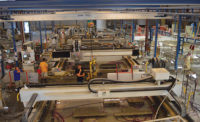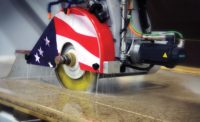What does “The Digital Revolution” mean with regards to manufacturing? One reasonable definition is “the movement from manual processes, to computer aided processes within the manufacturing realm.” Using this definition, it’s fair to include everything from CNC machining to CAD/CAM — and even word processing, accounting and the internet.
Early adopters of digital technology included automotive and aerospace, but by the 1980s, the cost of computers, CNC machines and software reached a level where smaller businesses could afford to use it. Today, in industries like metal, wood and plastics; CNC, CAD/CAM and the various accessories to digital manufacturing are now accepted as the only possible way to operate a profitable business.
While the stone industry may have started a little later, there is no question that it will follow the same path. Profitability will increasingly depend on leveraging the tools and processes encompassed by the digital revolution.
There is more to do
For the most part, the stone industry has thus far leveraged existing technologies and adapted them for its particular needs, but that is beginning to change. With the growing use of digital tools, the stone industry has created a need for technology that is specific to it. This same need has made it profitable for creative companies to apply their resources to products that are designed directly for the stone industry and not just pressed into use on an ad hoc basis.
In 2015, stone fabricators are now able to digitally measure and draw, control their schedules, manage their books, create complex layouts, cut their slabs and more — all within the digital realm — while using tools that are specifically designed for the problems unique to the stone industry.
Still, it would be a mistake to believe that the stone industry has completed its journey into the digital age. There remain many holes and gaps that are being pursued and painstakingly filled to bring the stone industry to a level roughly parallel with what is typical of most other manufacturing industries operating in the current world market.
The ramifications of digital slabs
One of the newer steps up on the stone industry’s digital ladder has been the notion of a digital slab. A digital slab should not be thought of as a picture of a slab. It is more appropriate to think of a digital slab as an accurate copy of real life.
A true digital slab must be dimensionally and color accurate. It must also include all of the properties of the slab that are crucial or simply useful to each of the levels a slab passes through during its life cycle. It’s fair to say that a digital slab can add value to all levels of the slab industry, including the original slab manufacturer, distribution, marketing, sales, fabrication, installation and beyond.
Fabricators and digital slabs
There are many concrete examples of how digital slabs have changed the way fabricators conduct their business. Artisan Stoneworks of Long Island, NY, specializes in high-end retail floors. The company uses digital slabs — giving it the ability to layout entire store floors, which may contain anywhere from 35 to as many as 150 slabs. As part of the deliverables in Artisan’s quotes, it includes pictures of each slab, the position of each piece of the floor in the slab and high-resolution images of the final job all cross referenced with the slabs. This resulted in the architect for one large retail chain writing this ability into all future proposals. “We couldn’t do the level of work we are doing without the use of digital slabs,” said Mitch Gusman of Artisan.
Another company that has made digital slabs an important part of its business is Brekhus Tile and Stone of Denver, CO. The company specializes in large-scale decorative floors. Recently, Brekhus completed a floor for AMG Bank in Denver. The floor consists of a mosaic of different natural stones.
“When we began work on this project, our customer saw some of the early layouts and couldn’t believe what we could produce from the slabs they selected,” said Jeff Brekhus, the company’s CEO. “The ability to pick and choose from specific areas of a digital slab to create intricate patterns was virtually impossible until we embraced this technology.”
Progressive fabricators are finding many other ways to leverage digital slabs within their businesses, including:
• Increased Yield — The dimensional accuracy of a digital slab in combination with strong layout tools greatly increases yield. Gabriel Rosito Luce, one of the owners of Rosito Luce in Porto Allegre, Brazil said, “We are regularly utilizing upwards of 95% of each slab now that we are creating digital slabs and have the software to create our layouts.” In all cases, yield is significantly improved.
• Sales/Customer Satisfaction – Being able to provide understandable, precise and manufacturable digital layout choices to a customer — before cutting the slabs — increases customer satisfaction, eliminates customer surprises on install and changes the sales process from a cost-based decision to an “I want that countertop” decision. This often results in higher profit sales.
• Remnant Usage – The ability to search digital slab inventory by “usable area,” and to color match a remnant with another material in a layout, enables fabricators to greatly increase the likelihood of finding and using their off-cuts.
• Reduced Handling – Maintaining a digital inventory of slabs greatly reduces the need to handle slabs while in inventory. Customer’s slab choices can be narrowed down or eliminated digitally instead of physically moving and viewing each potential slab.
• Inventory/Purchasing Decisions –Better purchasing decisions can be made when the exact square footage of any particular material is easily found. Digital slabs allow material totals based on the “usable area” within a slab or remnant as opposed to a “guest-a-mate,” based on the rough length and width of a particular material.
• Live Inventory – Some fabricators are using digital slabs to present real-time live digital inventory on their websites.
What’s the next step for digital slabs?
While fabricators have been using and expanding the uses of digital slabs for a number of years, a new phase is occurring in the industry. Manufacturers are beginning to see the added value to digital slabs.
The first slab manufacturer to fully appreciate the ramifications of digital slabs to its business is The Cosentino Group of Cantoria, Spain. As one of the largest suppliers of natural granite from Brazil, the company was looking for a way to add value to its product and increase sales to its fabrication customers.
Juan Alvarez, Director of Natural Stone & CDS Center Distribution Support of Cosentino corporate offices in Houston, TX, spearheaded this project. “We were looking for more than a pretty picture,” he explained. “We wanted a higher value than that for the investment we were making. As we researched the market, we noticed a sizable portion of our customers were already using digital slabs within their business, and it soon became clear that the standard for digital slabs was Slabsmith software.” Alvarez contacted Northwood Designs, Inc. of Antwerp, NY, the developers of Slabsmith, to explore what a partnership with Slabsmith would provide to help him reach his goals. “After talking to the people at Slabsmith, we developed a long-term strategy which included creating digital slabs at our plant in Brazil, as well as developing a ‘Digital Warehouse’ website for our fabrication customers,” said Alvarez. “We saw this as an obvious way to provide our customer with a significant value-added when purchasing slabs from Cosentino.”
For the first step of this process, Northwood Designs worked with Cosentino to design and build a custom digital photo station on each of its four slab lines in Serra, Brazil.
The Slabsmith software creates a digital slab by combining the calibrated photo from the photo station with the slab properties, which are pulled from the Cosentino SAP database in Spain. This joined information is then inserted into the Slabsmith database in Brazil to create a digital slab.
After creating the digital slab, Slabsmith generates web appropriate images for Cosentino’s Digital Warehouse website, as well as a serialized record of the digital slab in the form of a “.slab” file. These images and the .slab file are then uploaded to Cosentino’s B2B website for use by its fabrication customers.
“It’s been a long road to complete all the pieces to this project, but it has been worth it,” said Alvarez. “Our customers love being able to view and order from accurate images of each slab on our website, and they also love the ability to download the .slab file to use directly in their Slabsmith software without having to first create the digital slab themselves. On top of that, we found secondary benefits. For the first time, we have an accurate internal record of every slab we manufacture. This has been great for us.”
Cosentino’s digital slabs in use
Solid Surfaces, Inc. of Rochester, NY, is one of the early adopters of digital slab technology, as well as one of the initial users of the Cosentino’s complete digital slab system. Mitch Makowski, the owner of Solid Surfaces, spoke about one of his recent jobs using this new process. “I have been using Slabsmith within my business for many years now, and I was very excited to learn that I would be able to download a digital slab from Cosentino’s Digital Warehouse and use it with no additional time or work involved,” he said. “We recently completed our first job using the Cosentino Digital Warehouse website. It was for a local customer and it went off without a hitch. The customer was ecstatic and the finished job turned out perfect.
“The process turned out to be quick and easy,” Makowski went on to say. “We selected the slabs from Cosentino’s website, downloaded the .slab files and imported them into our local Slabsmith system. From that point on, it was just a matter of using our normal processes. First we made a couple of layouts for the customer, then we emailed the layout pictures to the customer. The customer selected their favorite layout, we cut the job and installed it — all in about three days.”
It’s just the beginning
Bill Elliott is the CEO of Northwood Designs, the developer of Slabsmith. “We were very excited to work with Cosentino on this project, they are helping us to realize a vision we had many years ago,” he said. “We have believed since shortly after we began development of Slabsmith that the earlier a digital slab was created, the more value there would be to everyone in the supply chain — from manufacturer all the way to the customer buying a countertop. While Cosentino is the first to fully implement this process, we are currently working with other manufacturers, such as Cambria in the U.S., to provide similar benefits to them and their customers. We truly believe digital slabs are the logical — and ultimately the best way — to benefit everyone who works within the stone industry.”












